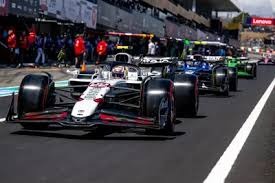McLaren’s Strategy Debate: Did They Miss an Opportunity in the Japanese Grand Prix?
The 2025 Japanese Grand Prix presented an intriguing strategic battle between Red Bull and McLaren, with Max Verstappen emerging victorious over Lando Norris and Oscar Piastri. A key moment came during the pit stop phase when McLaren decided to bring Norris in on the same lap as Verstappen, leading to questions about whether they squandered a potential race win. This analysis examines the strategic options available to McLaren and evaluates whether their approach cost them victory.
The Critical Pit Stop Decision
The pivotal moment of the race centered around the sole pit stop window. With Verstappen leading Norris by approximately 1.5 seconds, McLaren faced a crucial strategic decision. The team first brought in Oscar Piastri from third position on lap 21 to cover off George Russell’s Mercedes, which had pitted the previous lap[2]. Red Bull responded by bringing Verstappen in on the following lap, and McLaren made the contested decision to pit Norris on the same lap rather than trying an alternative strategy[1].
This simultaneous pit stop led to a dramatic moment as both drivers exited the pits, with Norris drawing alongside Verstappen but ultimately having to take to the grass at the pit exit, maintaining their previous running order[5]. The incident was noted but not investigated further by the stewards[5].
McLaren’s decision to shadow Verstappen’s strategy rather than attempt something different drew criticism from several observers, including 1997 World Champion Jacques Villeneuve, who claimed the team was “completely panicking, fearing to make the right decisions”[11].
Strategic Alternatives: What Could McLaren Have Done?
The Undercut Option
One alternative would have been to pit Norris before Verstappen to attempt an undercut. However, McLaren team principal Andrea Stella defended not pursuing this strategy:
- Traffic concerns: Had Norris pitted a lap earlier, he would likely have emerged behind Oliver Bearman’s Haas, negating any potential advantage[14].
- Team priorities: Pitting Piastri first was necessary to cover Russell’s Mercedes and protect their podium position[8].
- Championship considerations: McLaren was balancing their constructors’ championship lead with individual driver opportunities[6].
The Overcut Option
Another possibility was leaving Norris out longer after Verstappen pitted, hoping to gain time on fresher tires later:
- Tire performance: Stella insisted that fresh hard tires offered such a significant advantage that the overcut wouldn’t have worked[2].
- Low degradation: The newly resurfaced Suzuka track showed minimal tire wear, meaning older tires would be at a substantial disadvantage[2][4].
- Position risk: Staying out longer might have exposed Norris to losing positions to other drivers who had already pitted, including potentially his teammate Piastri[4][8].
Track Characteristics and Race Context
A critical factor in evaluating McLaren’s strategy is understanding the unique characteristics of Suzuka in 2025:
- Overtaking difficulty: Multiple sources indicated that passing at Suzuka required a pace advantage of approximately 0.8-1.4 seconds per lap[2][8].
- Resurfaced track: The first sector of Suzuka had been newly paved, dramatically changing its “personality” with much lower tire degradation than in previous years[2].
- Race effectively decided in qualifying: Stella claimed that “the race was mostly decided yesterday” when Verstappen secured pole by just 0.012 seconds over Norris[4][13].
McLaren’s Conservative Approach
Some analysis suggests McLaren’s overall approach to race strategy reflects a more cautious philosophy:
- Team versus individual: McLaren appeared to prioritize maximizing team points rather than taking risks for an individual win[12].
- Equal treatment: Unlike Red Bull’s focus on Verstappen, McLaren maintained equality between their drivers, potentially diluting their strategic aggression[7].
- Constructors’ priority: The team seemed to value securing a 2-3 finish to extend their lead in the constructors’ championship over gambling for a win[12].
Jacques Villeneuve noted this conservative mindset, stating that McLaren “didn’t seem to be overly disappointed which is strange… They should have been first and second but were beaten, not because they were slow, but because a team and a driver were better”[15].
Technical Execution
Despite the strategic debate, the execution of the pit stops themselves showed McLaren’s competence:
- Faster stop: Norris actually had a quicker pit stop than Verstappen (2.3 seconds versus 3.3 seconds)[5].
- Close contest: The fact that Norris was able to challenge Verstappen at the pit exit demonstrated how fine the margins were[5].
- Dummy attempt: McLaren tried to deceive Red Bull with a dummy pit call for Norris before the actual stops, though Red Bull didn’t take the bait[3].
Conclusion
Did McLaren “throw away” the Japanese Grand Prix with their pit strategy? The evidence suggests a more nuanced conclusion than a simple yes or no. While there were alternative strategies that might have given Norris a chance to overtake Verstappen, McLaren was operating under significant constraints including track position, traffic considerations, and the particular characteristics of Suzuka in 2025.
The team’s approach appears consistent with their philosophy of balanced risk management and team optimization rather than aggressive gambling for individual wins. This may reflect a strategic difference between McLaren and Red Bull, with the latter more willing to focus resources on Verstappen’s success.
What seems clear is that McLaren had a car capable of winning the race but lost the battle for track position in qualifying by the smallest of margins. In a race where overtaking proved nearly impossible, that qualifying result effectively determined the outcome more than any subsequent strategy decision.
The debate over McLaren’s approach will likely continue, but it highlights the complex trade-offs teams must make between aggression and consistency in pursuit of both championships.
Citations:
[1] https://www.gpblog.com/en/general/mclaren-choose-a-remarkable-pit-stop-strategy-did-norris-lose-to-verstappen-because-of-it
[2] https://www.racefans.net/2025/04/06/mclaren-denies-its-strategy-cost-norris-chance-to-win-japanese-grand-prix/
[3] https://www.planetf1.com/news/christian-horner-mclaren-pit-stop-dummy-didnt-make-any-sense-japanese-gp
[4] https://www.formula1.com/en/latest/article/stella-explains-why-mclarens-hands-were-tied-in-strategic-japanese-gp-battle.21tD15oGZTjJP7uXpoOOQY
[5] https://www.the-race.com/formula-1/verstappen-beats-mclaren-drivers-japanese-gp-f1-norris-pitlane-run-in/
[6] https://www.crash.net/f1/news/1066994/1/analysis-did-mclaren-give-away-victory-red-bull-japanese-gp
[7] https://www.racefans.net/2025/04/06/did-mclaren-miss-a-chance-to-beat-verstappen-japanese-gp-data-analysed/
[8] https://www.the-race.com/formula-1/red-bull-poised-to-exploit-mclaren-biggest-strength/
[9] https://www.motorsport.com/f1/news/mclaren-chief-defends-japanese-gp-strategy-not-possible-to-overtake/10710410/
[10] https://www.planetf1.com/news/japanese-gp-max-verstappen-manages-mclaren-lando-norris-rivalry-ignites
[11] https://sports.yahoo.com/article/jacques-villeneuve-slams-mclaren-panic-064244638.html
[12] https://thejudge13.com/2025/04/06/mclaren-safe-strategy-lacks-winning-mentality/
[13] https://www.formula1.com/en/latest/article/norris-concedes-mclaren-had-nothing-special-in-japan-as-he-gives-verdict-on.7yjYVyIpCWcBG7Iuec0CkQ
[14] https://www.the-race.com/formula-1/mark-hughes-where-mclaren-lost-winnable-japanese-gp-to-verstappen-f1/
[15] https://www.crash.net/f1/news/1066981/1/mclarens-strange-reaction-japanese-gp-defeat-questioned-should-hurt
[16] https://www.reddit.com/r/formula1/comments/1jss3ec/mclaren_couldnt_risk_alternate_japan_strategy/
[17] https://www.youtube.com/watch?v=gFZvv5qEQnI
[18] https://www.reddit.com/r/formula1/comments/1jthsgk/equal_driver_policy_compromised_mclarens_japanese/

